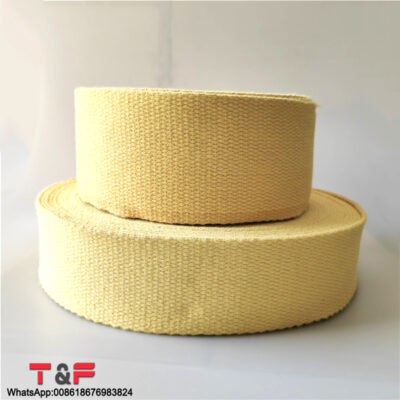Fire Eating
Kevlar wicks
Definition:
Kevlar is the brand name of a high temperature synthetic aramid fiber. Other similar products are Nomex and Technora.
Kevlar was first used by Renegade Juggling in 1984 to make flame torch juggling wicks. The material replaces asbestos cores used before they were known to cause cancer. At the time, asbestos cores were reinforced with very thin wire because they were so brittle. Today, Kevlar core-pulling does not require this reinforcing wire, although some jugglers still require it. Renegade named the new wicks “Kevlar Wicks” and they were widely adopted, even though most fire wicks were not actually made from Kevlar brand aramid fibers.
Kevlar Wicking For Fire Props
The weave of tape depends on the thickness, and twill is the best weave. If a strand of thread burns or breaks due to wear, the fabric will not unravel. Conversely, if one or two strands break in a cross weave, the others will also separate. Note that twill fabrics are not usually used to make 1/16 inch thick materials. If it’s a simple cross weave, it’s best to use 1/8 of an inch for half suction rather than 1/16 of an inch for double suction.
The thread used to make the tape varies. There are many types of wire used to make Kevlar wicks.
The fiber core Kevlar core has a very tiny fiberglass core around which the Kevlar yarn spins. This gives the thread more volume, but won’t break as it weaves on the machine. The fluffier the line, the more fuel it can hold. However, the fluffier it is, the less abrasive it will be. Low quality spinning incorporates fiberglass (which is much cheaper and heavier than Kevlar) into the yarn before spinning. When woven into a core, the result is a much denser thread and a higher total weight. Plus, these fiberglass don’t hold as much fuel as Kevlar. Often cheap wicks are made with a low quality cross weave pattern, which makes them faster to produce.
Given that Kevlar is a brand name, cheaper wicks manufacturers may use Kevlar -like aramid fibers. There are other brands of aramid wire that have the same physical properties as Kevlar wire, and most (if not all) Kevlar wicks are not made of Kevlar brand material because of its exorbitant price.
Technora is another brand of aramid fiber that is rated at around 900 degrees Fahrenheit compared to Kevlar. Currently, Technora is available only in rope form. It does not have very good fuel absorption properties, so it is mainly used as a belt material rather than a core material.
There are two ways to make Renegades’ Kevlar cords. The first has an outer braided sleeve and Kevlar wool strain-filled sleeve or tube. This configuration allows the rope to carry a lot of fuel, but it is not strong enough to lift heavy loads. Therefore, it can only be used as a wick and not for load-bearing purposes. You can also use it as an insulating gasket. The second type is a 12-strand braided rope with continuous strands but no core. This makes the rope very strong, but it can’t carry as much fuel as a linear core. Therefore, this type of rope is more suitable as material for belts or for making props and has a very high level of wear and tear.
Kevlar Wick Sizes
Flat wicks come in a variety of sizes. The most commonly used size in many props is 2 x 1/8 inches. It is good to do a folding poi wick; 4 inch cores can also be made when placed side by side. Short pieces are good for fire fans and other props. When you buy a 100-foot roll of wicks, there’s a 20% discount. If you’re not sure what size to try, this is a good starting point to make a wide variety of props.
Kevlar cords also come in many sizes depending on the use. To make a commonly used monkey fist, 3/8,1/2 and 5/8 inches are typical sizes. The larger the diameter, the larger the knot. When using rope to make a salamander, jump rope, lasso, or fire sword, you need to use a diameter of at least 5/8 inch or larger. Both the Renegade salamander and the jump rope use a one-inch rope.
Cleaning Fire Props With Kevlar Wicking
It is important to clean your fire prop after each use.
Many fireways feature a shiny or reflective surface combined with a wick. If you don’t clean up this reflective material, it will turn black and sooty, absorbing heat instead of reflecting it. Not cleaning up the soot can lead to unexpected hot props.
Soot from burning petroleum products should not come into contact with your skin or eyes. If the item is cleaned after each use, you will greatly reduce your exposure to these by-products.
Many props use silicon covers for insulation. When it burns, it produces silica. The powder and soot should not come into contact with your skin or eyes. Clean all silicon surfaces after each use.
Be sure to put a lid on the head of the wick when not in use. Use a cover to prevent soot from getting on your skin and in your eyes during transportation or during practice. Socks solve this problem well, and can be washed or thrown away after oversaturating with soot. Lightweight gloves also keep hands clean during practice.
Clean items reduce your exposure to toxic compounds. Play safe. Remember to clean your fire prop often and wash your hands after use. Baby wipes have easy-to-transport dispensers, perfect for cleaning up after each fire.
We support both Aramed wick ( a little fiberglass inside) and 100% pure Kevlar wicks, which come with best quality and competitive price. Any size and thickness is available here. Contact us, to get a free sample for testing!







